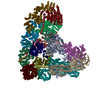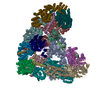[English] 日本語
 Yorodumi
Yorodumi- EMDB-2925: Cryo-EM structure of the human APC/C-Cdh1-Hsl1-UbcH10-Ub complex. -
+ Open data
Open data
- Basic information
Basic information
| Entry | Database: EMDB / ID: EMD-2925 | |||||||||
|---|---|---|---|---|---|---|---|---|---|---|
| Title | Cryo-EM structure of the human APC/C-Cdh1-Hsl1-UbcH10-Ub complex. | |||||||||
 Map data Map data | Cryo-EM structure of the human APC/C-Cdh1-Hsl1-UbcH10-Ub complex. | |||||||||
 Sample Sample |
| |||||||||
 Keywords Keywords |  Ubiquitination / Ubiquitination /  Cell cycle. Cell cycle. | |||||||||
| Function / homology |  Function and homology information Function and homology informationnegative regulation of mitotic spindle pole body separation / Conversion from APC/C:Cdc20 to APC/C:Cdh1 in late anaphase / : / deactivation of mitotic spindle assembly checkpoint / positive regulation of anaphase-promoting complex-dependent catabolic process / positive regulation of exit from mitosis / regulation of mitotic cell cycle spindle assembly checkpoint / free ubiquitin chain polymerization / Antigen processing: Ubiquitination & Proteasome degradation / positive regulation of synapse maturation ...negative regulation of mitotic spindle pole body separation / Conversion from APC/C:Cdc20 to APC/C:Cdh1 in late anaphase / : / deactivation of mitotic spindle assembly checkpoint / positive regulation of anaphase-promoting complex-dependent catabolic process / positive regulation of exit from mitosis / regulation of mitotic cell cycle spindle assembly checkpoint / free ubiquitin chain polymerization / Antigen processing: Ubiquitination & Proteasome degradation / positive regulation of synapse maturation / Conversion from APC/C:Cdc20 to APC/C:Cdh1 in late anaphase / Inactivation of APC/C via direct inhibition of the APC/C complex / APC/C:Cdc20 mediated degradation of mitotic proteins /  anaphase-promoting complex / Aberrant regulation of mitotic exit in cancer due to RB1 defects / anaphase-promoting complex-dependent catabolic process / regulation of meiotic cell cycle / positive regulation of mitotic metaphase/anaphase transition / metaphase/anaphase transition of mitotic cell cycle / (E3-independent) E2 ubiquitin-conjugating enzyme / regulation of exit from mitosis / positive regulation of synaptic plasticity / Antigen processing: Ubiquitination & Proteasome degradation / Phosphorylation of the APC/C / anaphase-promoting complex / Aberrant regulation of mitotic exit in cancer due to RB1 defects / anaphase-promoting complex-dependent catabolic process / regulation of meiotic cell cycle / positive regulation of mitotic metaphase/anaphase transition / metaphase/anaphase transition of mitotic cell cycle / (E3-independent) E2 ubiquitin-conjugating enzyme / regulation of exit from mitosis / positive regulation of synaptic plasticity / Antigen processing: Ubiquitination & Proteasome degradation / Phosphorylation of the APC/C /  anaphase-promoting complex binding / ubiquitin ligase activator activity / positive regulation of ubiquitin protein ligase activity / exit from mitosis / positive regulation of ubiquitin-dependent protein catabolic process / protein K11-linked ubiquitination / enzyme-substrate adaptor activity / regulation of mitotic metaphase/anaphase transition / positive regulation of dendrite morphogenesis / ubiquitin-ubiquitin ligase activity / anaphase-promoting complex binding / ubiquitin ligase activator activity / positive regulation of ubiquitin protein ligase activity / exit from mitosis / positive regulation of ubiquitin-dependent protein catabolic process / protein K11-linked ubiquitination / enzyme-substrate adaptor activity / regulation of mitotic metaphase/anaphase transition / positive regulation of dendrite morphogenesis / ubiquitin-ubiquitin ligase activity /  E2 ubiquitin-conjugating enzyme / mitotic metaphase chromosome alignment / ubiquitin conjugating enzyme activity / ubiquitin-like protein ligase binding / regulation of mitotic cell cycle / cullin family protein binding / Regulation of APC/C activators between G1/S and early anaphase / Transcriptional Regulation by VENTX / protein K48-linked ubiquitination / positive regulation of axon extension / E2 ubiquitin-conjugating enzyme / mitotic metaphase chromosome alignment / ubiquitin conjugating enzyme activity / ubiquitin-like protein ligase binding / regulation of mitotic cell cycle / cullin family protein binding / Regulation of APC/C activators between G1/S and early anaphase / Transcriptional Regulation by VENTX / protein K48-linked ubiquitination / positive regulation of axon extension /  heterochromatin / heterochromatin /  ubiquitin ligase complex / APC/C:Cdc20 mediated degradation of Cyclin B / APC-Cdc20 mediated degradation of Nek2A / nuclear periphery / Synthesis of active ubiquitin: roles of E1 and E2 enzymes / ubiquitin ligase complex / APC/C:Cdc20 mediated degradation of Cyclin B / APC-Cdc20 mediated degradation of Nek2A / nuclear periphery / Synthesis of active ubiquitin: roles of E1 and E2 enzymes /  cyclin binding / Autodegradation of Cdh1 by Cdh1:APC/C / APC/C:Cdc20 mediated degradation of Securin / positive regulation of protein ubiquitination / Assembly of the pre-replicative complex / Cdc20:Phospho-APC/C mediated degradation of Cyclin A / cyclin binding / Autodegradation of Cdh1 by Cdh1:APC/C / APC/C:Cdc20 mediated degradation of Securin / positive regulation of protein ubiquitination / Assembly of the pre-replicative complex / Cdc20:Phospho-APC/C mediated degradation of Cyclin A /  brain development / APC/C:Cdh1 mediated degradation of Cdc20 and other APC/C:Cdh1 targeted proteins in late mitosis/early G1 / spindle / brain development / APC/C:Cdh1 mediated degradation of Cdc20 and other APC/C:Cdh1 targeted proteins in late mitosis/early G1 / spindle /  mitotic spindle / mitotic spindle /  kinetochore / CDK-mediated phosphorylation and removal of Cdc6 / protein polyubiquitination / ubiquitin-protein transferase activity / positive regulation of protein catabolic process / Separation of Sister Chromatids / kinetochore / CDK-mediated phosphorylation and removal of Cdc6 / protein polyubiquitination / ubiquitin-protein transferase activity / positive regulation of protein catabolic process / Separation of Sister Chromatids /  ubiquitin protein ligase activity / microtubule cytoskeleton / Antigen processing: Ubiquitination & Proteasome degradation / mitotic cell cycle / ubiquitin protein ligase activity / microtubule cytoskeleton / Antigen processing: Ubiquitination & Proteasome degradation / mitotic cell cycle /  nervous system development / ubiquitin-dependent protein catabolic process / Senescence-Associated Secretory Phenotype (SASP) / nervous system development / ubiquitin-dependent protein catabolic process / Senescence-Associated Secretory Phenotype (SASP) /  protein phosphatase binding / protein phosphatase binding /  cell differentiation / molecular adaptor activity / protein ubiquitination / cell differentiation / molecular adaptor activity / protein ubiquitination /  cell cycle / cell cycle /  cell division / negative regulation of gene expression / cell division / negative regulation of gene expression /  centrosome / centrosome /  ubiquitin protein ligase binding / ubiquitin protein ligase binding /  nucleolus / zinc ion binding / nucleolus / zinc ion binding /  nucleoplasm / nucleoplasm /  ATP binding / ATP binding /  nucleus / nucleus /  plasma membrane / plasma membrane /  cytosol / cytosol /  cytoplasm cytoplasmSimilarity search - Function | |||||||||
| Biological species |   Homo sapiens (human) Homo sapiens (human) | |||||||||
| Method |  single particle reconstruction / single particle reconstruction /  cryo EM / Resolution: 5.7 Å cryo EM / Resolution: 5.7 Å | |||||||||
 Authors Authors | Chang L / Zhang Z / Yang J / McLaughlin SH / Barford D | |||||||||
 Citation Citation |  Journal: Nature / Year: 2015 Journal: Nature / Year: 2015Title: Atomic structure of the APC/C and its mechanism of protein ubiquitination. Authors: Leifu Chang / Ziguo Zhang / Jing Yang / Stephen H McLaughlin / David Barford /  Abstract: The anaphase-promoting complex (APC/C) is a multimeric RING E3 ubiquitin ligase that controls chromosome segregation and mitotic exit. Its regulation by coactivator subunits, phosphorylation, the ...The anaphase-promoting complex (APC/C) is a multimeric RING E3 ubiquitin ligase that controls chromosome segregation and mitotic exit. Its regulation by coactivator subunits, phosphorylation, the mitotic checkpoint complex and interphase early mitotic inhibitor 1 (Emi1) ensures the correct order and timing of distinct cell-cycle transitions. Here we use cryo-electron microscopy to determine atomic structures of APC/C-coactivator complexes with either Emi1 or a UbcH10-ubiquitin conjugate. These structures define the architecture of all APC/C subunits, the position of the catalytic module and explain how Emi1 mediates inhibition of the two E2s UbcH10 and Ube2S. Definition of Cdh1 interactions with the APC/C indicates how they are antagonized by Cdh1 phosphorylation. The structure of the APC/C with UbcH10-ubiquitin reveals insights into the initiating ubiquitination reaction. Our results provide a quantitative framework for the design of future experiments to investigate APC/C functions in vivo. | |||||||||
| History |
|
- Structure visualization
Structure visualization
| Movie |
 Movie viewer Movie viewer |
|---|---|
| Structure viewer | EM map:  SurfView SurfView Molmil Molmil Jmol/JSmol Jmol/JSmol |
| Supplemental images |
- Downloads & links
Downloads & links
-EMDB archive
| Map data |  emd_2925.map.gz emd_2925.map.gz | 4.3 MB |  EMDB map data format EMDB map data format | |
|---|---|---|---|---|
| Header (meta data) |  emd-2925-v30.xml emd-2925-v30.xml emd-2925.xml emd-2925.xml | 18.7 KB 18.7 KB | Display Display |  EMDB header EMDB header |
| Images |  emd_2925.jpg emd_2925.jpg | 118.8 KB | ||
| Archive directory |  http://ftp.pdbj.org/pub/emdb/structures/EMD-2925 http://ftp.pdbj.org/pub/emdb/structures/EMD-2925 ftp://ftp.pdbj.org/pub/emdb/structures/EMD-2925 ftp://ftp.pdbj.org/pub/emdb/structures/EMD-2925 | HTTPS FTP |
-Related structure data
| Related structure data |  5a31MC  2924C  2926C  4ui9C M: atomic model generated by this map C: citing same article ( |
|---|---|
| Similar structure data |
- Links
Links
| EMDB pages |  EMDB (EBI/PDBe) / EMDB (EBI/PDBe) /  EMDataResource EMDataResource |
|---|---|
| Related items in Molecule of the Month |
- Map
Map
| File |  Download / File: emd_2925.map.gz / Format: CCP4 / Size: 29.8 MB / Type: IMAGE STORED AS FLOATING POINT NUMBER (4 BYTES) Download / File: emd_2925.map.gz / Format: CCP4 / Size: 29.8 MB / Type: IMAGE STORED AS FLOATING POINT NUMBER (4 BYTES) | ||||||||||||||||||||||||||||||||||||||||||||||||||||||||||||
|---|---|---|---|---|---|---|---|---|---|---|---|---|---|---|---|---|---|---|---|---|---|---|---|---|---|---|---|---|---|---|---|---|---|---|---|---|---|---|---|---|---|---|---|---|---|---|---|---|---|---|---|---|---|---|---|---|---|---|---|---|---|
| Annotation | Cryo-EM structure of the human APC/C-Cdh1-Hsl1-UbcH10-Ub complex. | ||||||||||||||||||||||||||||||||||||||||||||||||||||||||||||
| Voxel size | X=Y=Z: 1.77 Å | ||||||||||||||||||||||||||||||||||||||||||||||||||||||||||||
| Density |
| ||||||||||||||||||||||||||||||||||||||||||||||||||||||||||||
| Symmetry | Space group: 1 | ||||||||||||||||||||||||||||||||||||||||||||||||||||||||||||
| Details | EMDB XML:
CCP4 map header:
| ||||||||||||||||||||||||||||||||||||||||||||||||||||||||||||
-Supplemental data
- Sample components
Sample components
+Entire : Recombinant human APC/C-Cdh1-Hsl1-UbcH10LR-Ub complex
+Supramolecule #1000: Recombinant human APC/C-Cdh1-Hsl1-UbcH10LR-Ub complex
+Macromolecule #1: Apc1
+Macromolecule #2: Apc2
+Macromolecule #3: Apc3
+Macromolecule #4: Apc4
+Macromolecule #5: Apc5
+Macromolecule #6: Apc6
+Macromolecule #7: Apc7
+Macromolecule #8: Apc8
+Macromolecule #9: Apc10
+Macromolecule #10: Apc11
+Macromolecule #11: Apc12
+Macromolecule #12: Apc13
+Macromolecule #13: Apc15
+Macromolecule #14: Apc16
+Macromolecule #15: Cdh1
+Macromolecule #16: Hsl1
+Macromolecule #17: E2-ubiquitin conjugate
+Macromolecule #18: UbcH10-ubiquitin
-Experimental details
-Structure determination
| Method |  cryo EM cryo EM |
|---|---|
 Processing Processing |  single particle reconstruction single particle reconstruction |
| Aggregation state | particle |
- Sample preparation
Sample preparation
| Concentration | 0.2 mg/mL |
|---|---|
| Buffer | pH: 8 / Details: 20 mM HEPES, 150 mM NaCl, 1 mM DTT |
| Grid | Details: R2/2 Quantifoil grid with thin carbon support. |
| Vitrification | Cryogen name: ETHANE / Chamber humidity: 100 % / Instrument: FEI VITROBOT MARK III / Method: Blot for 5 seconds before plunging |
- Electron microscopy
Electron microscopy
| Microscope | FEI POLARA 300 |
|---|---|
| Electron beam | Acceleration voltage: 300 kV / Electron source:  FIELD EMISSION GUN FIELD EMISSION GUN |
| Electron optics | Illumination mode: FLOOD BEAM / Imaging mode: BRIGHT FIELD Bright-field microscopy / Cs: 2.0 mm / Nominal defocus max: 4.0 µm / Nominal defocus min: 2.0 µm / Nominal magnification: 59000 Bright-field microscopy / Cs: 2.0 mm / Nominal defocus max: 4.0 µm / Nominal defocus min: 2.0 µm / Nominal magnification: 59000 |
| Sample stage | Specimen holder model: OTHER |
| Date | Jul 12, 2014 |
| Image recording | Category: CCD / Film or detector model: FEI FALCON II (4k x 4k) / Average electron dose: 16 e/Å2 |
| Experimental equipment |  Model: Tecnai Polara / Image courtesy: FEI Company |
- Image processing
Image processing
| CTF correction | Details: Each micrograph |
|---|---|
| Final reconstruction | Applied symmetry - Point group: C1 (asymmetric) / Resolution.type: BY AUTHOR / Resolution: 5.7 Å / Resolution method: OTHER / Software - Name: RELION / Number images used: 19939 |
| Details | The particles were selected using an automatic selection program |
 Movie
Movie Controller
Controller































